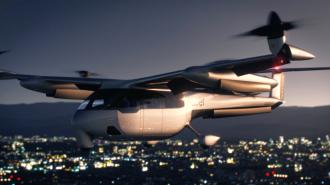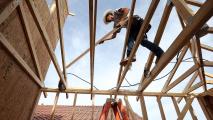It’s been the ultimate futuristic dream for decades: flying cars! But now, the future finally has a deadline. At least to start, it will land in the form of a small air taxi operated by Uber, not something you’ll park in your garage.
Uber Air, the ridesharing giant’s air taxi service, is slated to be fully operational in 2025, but it aims to get a pilot program off the ground in Dallas, Los Angeles, and Melbourne by 2023.
The fleet will be comprised of electric vertical takeoff and landing (eVTOL) aircraft. These drone-like vehicles use a combination of propellers, rotors, and wings to lift off and land in one spot, like a helicopter, while flying like a plane between destinations. Eventually, Uber envisions creating a series of “skyports,” but it could take advantage of existing helipad infrastructure in the meantime.
Uber Air, the ridesharing giant’s air taxi service, is slated to be fully operational in 2025, but it aims to get a pilot program off the ground in Dallas, Los Angeles, and Melbourne by 2023.
A New Aerospace Race
A number of helicopter and aerospace firms are currently working on prototypes for Uber’s eVTOL air taxis. The company’s design requirements include a 60-mile range, 150 mph cruising speed, the ability to handle a pilot and four passengers, and — a priority, although not explicitly listed — relatively quiet operation.
The marketplace is being created from scratch, says Andre Stein, Head of Strategy at EmbraerX, one of Uber’s design partners. Development of the eVTOL feels something like the beginnings of aviation to Stein, an exciting moment for new ideas and concepts.
“With the eVTOLs, we’re back to the early days of aerospace,” Stein says. “We’re back to the point that everyone is looking at a different type of configuration.” Some resemble helicopters; others, more like airplanes. But all will need to meet Uber’s design specifications.
Beyond the flight technology, a new aerospace race could create innovations that go beyond Uber Air, says Kaydon Stanzione, CEO of Jaunt, another Uber partner. He gives the development of batteries as an example: eVTOL batteries will need to be quick charging, powerful, and able to efficiently manage battery usage and the amount of power they draw. Advancements in battery technology for air taxis could have far ranging implications for anything that uses them as a power source.
But the eVTOL may not be the most difficult challenge. Working with the regulatory bodies that control airspace could prove even harder.
“Other than the electrification piece, what becomes even more of a quagmire for these regulatory entities is the fact that the designs themselves are very unconventional,” Stanzione says. So, too, is the manner in which they will be flying: up-tempo, with many take offs and landings per day, in already crowded urban airspace.
“With the eVTOLs, we’re back to the early days of aerospace. We’re back to the point that everyone is looking at a different type of configuration.” Some resemble helicopters; others, more like airplanes.
Flying Through the Red Tape
Airspace in the United States is controlled by the Federal Aviation Administration (FAA). When creating new regulations, the FAA focuses on “performance-based rulemaking,” setting safety standards but avoiding draconian, specific mandates about how to meet those standards. The idea, the FAA tells Freethink, is to allow room for new and innovative ideas to meet the safety standards and begin operating.
But significant new rules and regulations can still take years to write and implement. Uber’s ridesharing business was built with a notorious disregard for regulations, something that is simply not possible in aerospace. The company will need to work with regulators in advance this time, but that’s something the FAA says it welcomes.
“Uber, like many companies that are working toward UAM (urban air mobility), is a new entrant to the aviation community,” the FAA says. “These companies bring energy, creativity, and innovation. In order to be a part of the safest mode of transportation on the planet, these operators will need to comply with all requirements. We welcome the opportunity to work with these companies.”
Uber Air will fly in airspace that is low and crowded. Because of this, its vehicles need to operate under visual flight rules, says Jaunt’s Stanzione, which means that pilots must be able to see and avoid aircraft and obstacles.
“In the low altitude, high-density areas where Uber proposes to operate, the ability to see and avoid obstacles and other aircraft would be paramount,” the FAA says. The agency says that technology to detect these aviation dangers — which is still being developed — may one day allow for pilots to take longer flights beyond their line of sight.
Until then, the pilot must be able to see and avoid obstacles directly. This is easier to do in cities with generally fair weather, like Uber’s test markets, Stanzione points out.
A New Category of Aircraft
The eVTOL aircraft offer unique regulatory challenges. For Uber Elevate to launch, it will need not only to have its operating procedures approved by the FAA, but the new air taxi designs as well.
“They’re putting new vehicles in the airspace,” says Alice Grossman, a Senior Policy Analyst at the Eno Center for Transportation, a think tank in Washington, DC. “So it’s not just complying with regulations for operating once they’ve got them, but it’s getting the aircraft certified to begin with.”
Since eVTOL aircraft are capable of flying like both helicopters and planes, they do not fit neatly into any of the FAA’s current aircraft definitions and certifications, the agency says. Because regulations are performance-based, a new form of aircraft like an eVTOL will need to meet the standards of the FAA, rather than conform to old, pre-approved designs.
“Performance-based rules allow maximum flexibility in certifying what the aircraft can do to meet regulations,” the FAA says.
Being able to literally fly above traffic jams is an alluring and romantic solution to traffic congestion, but Uber Elevate as currently envisioned would not make an appreciable dent in ordinary commutes.
Aircraft safety regulations are extremely strict. Every component must be reliable to 10-9, meaning they must operate correctly 99.9999999% of the time, Stanzione says. Once this hurdle is surmounted, they can then be certified by the FAA.
The challenges of pioneering urban air mobility mean that Uber’s dates cannot be set in stone. There cannot be a timeline put on regulations, the FAA says, because so much is dependent on the experience and efforts of the companies.
That’s where the aerospace partners come into play again, says EmbraerX’s Stein. “Our DNA as an airplane manufacturer helps a lot.”
While Uber and their partners are seriously taking a run at the dream of flying cars, the challenges, especially on the regulatory side, are real, and the benefits may take longer to manifest.
Those benefits will probably have much more to do with access to rapid transportation on-demand than with alleviating the day to day problem of congestion. Being able to literally fly above traffic jams is an alluring and romantic solution to traffic congestion, but Uber Elevate as currently envisioned would not make an appreciable dent in ordinary commutes.
It’s an issue of geometry, Alice Grossman says: you need to fit more people into less space. An eVTOL carrying four passengers does less to ease congestion than, say, a city bus, which can carry far more people and takes advantage of technology and infrastructure that already exists.
Still, a successful launch of Uber Air could pave the way for other, more effective forms of urban air mobility. And wouldn’t it be nice to finally have the future arrive?






